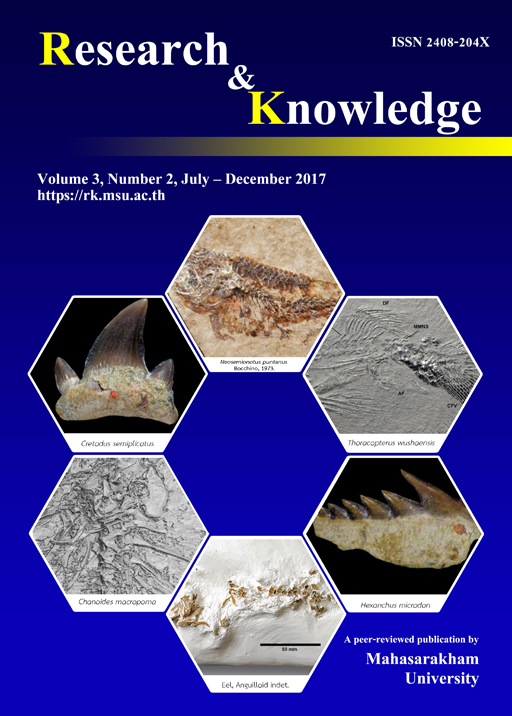A review of Mawsonia from the Ilhas Group, Marfim Formation (? Late Hauterivian), Recôncavo Basin
Keywords:
Postcranium, Mawsoniidae, Actinistia, Gondwana, Lower CretaceousAbstract
The Mawsoniidae family includes six genera Chinlea, Diplurus, Trachymetopon, Parnaibaia, Mawsonia and Axelrodichthys with an almost worldwide occurrence ranging from the Triassic to the Late Cretaceous. The genus Mawsonia is widely registered from the Western Gondwana (South America and Africa) and is currently found in layers of continental origin and in association with fresh water ostracods or with a peculiar continental vertebrate fauna. Here we redescribe some nearly complete skeletons of M. gigas. Mawsoniids are extremely common in the Western Gondwana and, yet various specimens from different basins are referred to M. gigas, this type species is still one of the most poorly known species of this family. The redescription of the specimens from Recôncavo Basin confirms its classification as M. gigas, based mainly on the postcranial skeleton.
References
Brito, P. M. and Richter, M. 2015. The contribution of Sir Arthur Smith Woodward to the palaeoichthyology of Brazil–Smith Woodward’s types from Brazil. Geological Society, London, Special Publications 430, 201-217. Carvalho, M. S. S. 1982. O gênero Mawsonia na ictiofáunula do Cretáceo do estado da Bahia. Anais da Academia Brasileira de Ciências 54, 519-539.
Carvalho, M. S. S. and Maisey, J. G. 2008. New occurrence of Mawsonia (Sarcopterygii: Actinistia) from the Early Cretaceous of the Sanfranciscana Basin, Minas Gerais, southeastern Brazil. Geological Society, London, Special Publications 295, 109-144.
Cavin, L. and Guinot, G. 2014. Coelacanths as “almost living fossils”. Frontiers in Ecology and Evolution 2, 49.
Cavin, L., Valentin, X. and Garcia, G. 2016. A new mawsoniid coelacanth (Actinistia) from the Upper Cretaceous of southern France. Cretaceous Research 62, 65-73.
Clément, G. 2005. A new coelacanth (Actinistia, Sarcopterygii) from the Jurassic of France, and the question of the closest relative fossil to Latimeria. Journal of Vertebrate Paleontology 25, 481-491.
Cope, E. D. 1871. Contribution to the ichthyology of the Lesser Antilles. Transactions of the American Philosophical Society, 445-483.
Cupello, C. D., Bermúdez-Rochas, D. D., Martill, D. M. and Brito, P. M. 2012. The hybodontiformes (Chondrichthyes: Elasmobranchii) from the Missão Velha Formation (? Lower Cretaceous) of the Araripe Basin, North-East Brazil. Comptes Rendus Palevol 11, 41-47.
Cupello, C., Batista, T. A., Fragoso, L. G., and Brito, P. M. 2016. Mawsoniid remains (Sarcopterygii: Actinistia) from the lacustrine Missão Velha Formation (Lower Cretaceous) of the Araripe Basin, North-East Brazil. Cretaceous Research 65, 10-16.
Dutel, H., Maisey, J. G., Schwimmer, D. R., Janvier, P., Herbin, M. and Clément, G. 2012. The giant Cretaceous coelacanth (Actinistia, Sarcopterygii) Megalocoelacanthus dobiei Schwimmer, Stewart and Williams, 1994, and its bearing on Latimerioidei interrelationships, Chicago. PLoS One 7, e49911.
Dutel, H., Herbin, M. and Clément, G. 2015. First occurrence of a mawsoniid coelacanth in the Early Jurassic of Europe. Journal of Vertebrate Paleontology 35, e929581.
Forey, P. L. 1998. History of the Coelacanth Fishes. Springer Science & Business Media, 419p.
Lopez-Arbarello, A., Rauhut, O. W. and Moser, K. 2008. Jurassic fishes of Gondwana. Revista de la Asociacion Geologica Argentina 63, 586-612.
Maisey, J. G. 1986. Coelacanths from the Lower Cretaceous of Brazil. American Museum novitates; no. 2866. Maisey, J. 1991. Santana Fossils: An Illustrated Atlas. T. F. H. Publications, Neptune City, NJ.
Miguel, R., Gallo, V. And Morrone, J. J. 2014. Distributional patterns of †Mawsoniidae (Sarcopterygii: Actinistia). Anais da Academia Brasileira de Ciências 86, 159-170.
Nulens, R., Scott, L. and Herbin, M. 2011. An Updated Inventory of all Known Specimens of the Coelacanth Latimeria spp South African Institute for Aquatic Biodiversity 3, 1–52.
Pouyaud, L., Wirjoatmodjo, S., Rachmatika, I., Tjakrawidjaja, A., Hadiaty, R. and Hadie, W. 1999. Une nouvelle espèce de coelacanthe: preuves génétiques et morphologiques. Comptes Rendus de l’Académie des Sciences-Series III-Sciences de la Vie 322, 261- 267.
Rasband, W. S. and Imagej, U. S. 1997-2016. National Institutes of Health, Bethesda, Maryland, USA, https://imagej.nih.gov/ij/. Schultze, H. P. 1993. Osteichthyes: Sarcopterygii. In: Benton, M. J. (Ed.), The Fossil Record 2. Chapman & Hall, London, 657-663.
Schultze, H. P. 2004. Mesozoic sarcopterygians. Mesozoic Fishes 3, 463-492. Smith, J. L. B. 1939. A living fish of Mesozoic type. Nature 143, 455-456.
Soto, M., De Carvalho, M. S., Maisey, J. G., Perea, D. and Silva, J. D. 2012. Coelacanth remains from the Late Jurassice? earliest Cretaceous of Uruguay: the southernmost occurrence of the Mawsoniidae. Journal of Vertebrate Paleontology 32, 530-537
Wenz, S. 1980. A propos du genre Mawsonia, Coelacanthe géant du Crétacé inférieur d’Afrique et du Brésil. Mémoires de la Société géologique de France 39, 187-190.
Woodward, A. S. 1907. Notes on some Upper Cretaceous Fish remains from the Province of Sergipe and Pernambuco, Brazil. Geological Magazine 4, 193-197.
Woodward, A. S. 1908. On some fossil fishes discovered by Prof. Ennes de Souza in the Cretaceous formation at Ilheos (State of Bahia), Brazil. Quarterly Journal of the Geological Society 64, 358-362.
Yabumoto, Y. 2002. A new coelacanth from the Early Cretaceous of Brazil (Sarcopterygii, Actinistia). Paleontological Research 6, 343-350.
Yabumoto, Y. 2008. A new Mesozoic coelacanth from Brazil (Sarcopterygii, Actinistia). Paleontological Research 12, 329-343.
Downloads
Published
How to Cite
Issue
Section
License

This work is licensed under a Creative Commons Attribution-NoDerivatives 4.0 International License.








